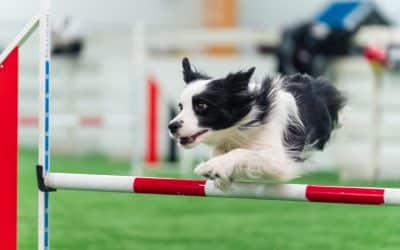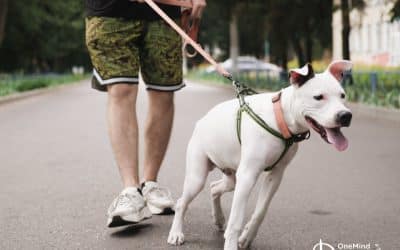From being afraid of dogs to loving them, Jane Bowman’s story is one of transformation and dedication. As a retired elementary school teacher and an avid dog trainer, she even discovered that the same training methods she used with canines worked just as well with her students.
In this blog post, we delve into Jane’s journey, discuss what inspires her about dogs, and explore how she applied her dog training skills to benefit both canines and children. You can catch her full story on our podcast, where we sat down with Jane to learn about her journey and the valuable lessons she has learned along the way.
Jane’s inspiration and motivation with dogs
For Jane, the bond that dogs provide is truly special. Believe it or not, Jane’s love for dogs and her passion for training them comes from a place of fear. In her early years, Jane was scared of dogs. This stemmed from encounters with neighborhood dogs who were less than friendly. The fear was so ingrained in her that she found herself avoiding any interaction with dogs.
However, everything changed one memorable day when Jane encountered a friendly Sheltie mix. Despite her initial impressions, she summoned the courage to pet the dog; at that moment, something shifted within her. The dog’s affectionate response melted away her fears and ignited an undying love for these incredible creatures.
Today, their unwavering love and loyalty inspire her daily. As a former teacher, she finds joy in training dogs because learning comes naturally to them – and they love it! Just like in the classroom, Jane appreciates seeing progress and growth in her four-legged students.
“Well, I like the bond that dogs give you. They love you no matter what, basically. I love training them, and I think that’s from being a teacher. I like to see learning, but dogs are just so easy to train and just so much fun to train,” says Jane.
But it’s not just training that brings her excitement; simple walks in the woods or tug-of-war games are equally fulfilling for Jane. The connection and shared experiences with her dogs create irreplaceable moments of happiness.
Jane’s introduction to OneMind Dogs
Looking for more guidance in her dog training journey, Jane stumbled upon OneMind Dogs at an agility trial ten years ago. The unique method and fresh approach of our online program became a game-changer for her knowledge and development as a trainer.
“I was eager to learn but had nowhere to go to learn things back then. I found this [OneMind Dogs] online, where I could search for what I wanted and even more than I knew I wanted to train. I mean, there’s just so much stuff on there. I joined immediately. It was the best thing I ever did.”
Through OneMind Dogs’ comprehensive materials, she found everything she needed – from puppy training techniques to advanced handling moves – all conveniently accessible online.
Jane also emphasizes the importance of finding local trainers who incorporate OneMind Dogs’ methods or are open to integrating them into their classes.
Eureka! The biggest light bulb moment in dog training
One of the most pivotal moments in Jane’s dog training journey came with her realization of the importance of understanding and handling the dog’s line. Initially, as she began her agility training with her small Havanese, she focused on running up to a jump and sending the dog over it, rather than handling a line of obstacles. The emphasis was solely on completing each obstacle separately, without paying attention to flow or the dog’s perspective.
The dog’s line refers to the path or trajectory a dog takes when running an agility course, guided by their handler’s cues. Before this understanding, Jane had been oblivious to how crucial it was for her movements and signals as a handler to reflect what her dog needed from their perspective.
With newfound knowledge in hand, Jane began implementing adjustments in her handling based on understanding what her dog was seeing and experiencing while completing jumps, tunnels, and weaving poles.
“For example,” explains Jane excitedly when recalling this turning point moment, “I used to reward my small Havanese for coming down from an A-frame by giving him treats once he completed his three hops to reach the yellow zone. But at trials with bigger A-frames, those same three hops would not reach that yellow zone.”
Jane continues with enthusiasm as she elaborates on how she realized that from her dog’s perspective, he had learned through repetition that three hops down were enough before jumping off the A-frame. Even though it might not align with her original intention, she understood that looking at things from the dog’s point of view was essential.
She adds, “I didn’t realize for the longest time until I actually watched a video, and I started thinking about it from the dog’s perspective […] It makes a great deal of difference in the ease of your handling. If you think about it from what the dog is looking at or even thinking, it’s a real eye-opener.”
Challenges and highlights in Jane’s dog training journey
Jane’s biggest challenge came when she welcomed her fast-paced rescue dog into her life. After all, at 67 years young, Jane’s speed is not what it used to be. Her initial approach involved sending her dog around the course while instructing from her own perspective. However, by the time she could blink an eye, her dog would already be three or four jumps ahead. It became clear that something needed to change.
“I mean, I really thought for a while that she was just too much dog for me. And other people even told me that or told me you need to slow that dog down.” Jane refused to buckle under the pressure;
“I’m not slowing the dog down.”
Taking a step back, Jane began to examine the situation from her dog’s perspective. She noticed that when giving cues with her arm or chest laser technique—where handlers point with their chest towards the desired direction—she was unintentionally signaling where the dog was going rather than where it needed to go.
Realizing this disconnect inspired Jane to shift her focus back onto understanding her dog’s perspective. No longer fixating on her arm or pointing gestures, she embraced a different approach centered around connection and eye contact.
Using her eyes to show the dog where to go and aligning her body movements accordingly, Jane found that this new form of clear communication resonated with her speedy companion.
Using the same training methods with kids
As a former elementary school teacher, it came naturally for Jane to adapt the positive reinforcement techniques she used with dogs to motivate children as well. Jane saw transformative results by rewarding good behavior and allowing children to accumulate tokens for desirable actions or achievements.
You see, she would often receive the “troubled” kids that the other teachers wanted to avoid. Jane was known for not punishing mistakes but rather helping the students learn through positive reinforcement.
“I gave them a token. You can’t give them candy or anything like you would give a dog treat, but I would give them a little token, and they could collect their tokens […] I had one little boy that didn’t want to come to read. He was going to sit under his desk and pout, and like, you don’t have to come. I’m not going to make you.”
Sure enough, upon seeing his classmates receiving tokens for their good behavior, the little boy eventually came around and was soon able to complete his reading assignment and collect tokens of his own.
Applying dog training methods in the classroom allowed Jane to create a supportive environment where children felt empowered and motivated to excel. It emphasizes the similarities in motivation and behavior between dogs and children, showing that positive reinforcement can be effective for both.
Be like Jane
Jane Bowman’s journey from being afraid of dogs to fostering an unbreakable bond with them is truly inspiring. Her use of the same training methods with her students proved successful in disciplining children and training well-mannered canines.
If you want to learn more about the OneMind Dogs method and Jane Bowman’s story, download our app today. You’ll find loads of interesting resources that will help you understand the principles of dog training and how to apply them to all aspects of your life. If you would like to hear more from our podcast series be sure to sign up for the newsletter by clicking here.



